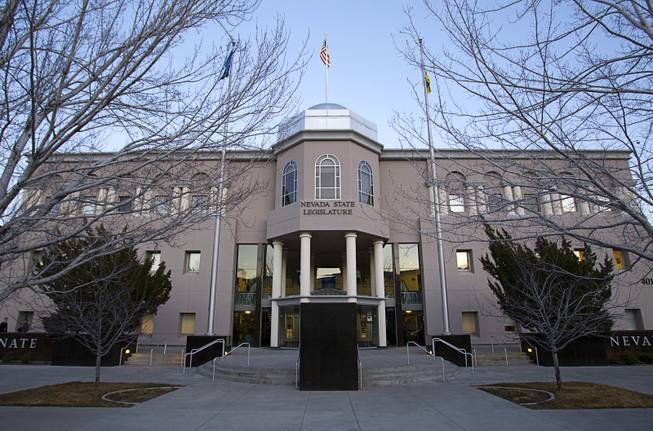
A view of the Nevada State Legislature building in Carson City on Monday, Feb. 11, 2013.
Sunday, May 5, 2013 | 2 a.m.
Greedy Northern Nevadans are hoarding the state’s money while Southern Nevada’s families and children go without.
Ever heard that one before?
For years, observers have noted how the state seems to operate a hypothetical conveyer belt that redistributes southern wealth in a way that favors northern road construction, schools and universities.
At the same time, some northern lawmakers are certain they’re donating to the south.
Wait. They can’t both be right, can they?
“They’re both right on the surface,” said John Restrepo, an economist with RCG Economics in Las Vegas.
Huh?
Well, here’s how this works:
GOP Assemblyman John Ellison of Elko said rural counties subsidize urban counties through the “net proceeds of minerals” taxes that mines pay to the state.
“Mining is paying a large portion,” Ellison said. “A lot of net proceeds of minerals goes back to the general fund, which helps the state.”
Translation: Mining counties are less like Scrooge and more like Santa.
It is true; mining money does flow southward from the north.
Meanwhile, southern legislators have been quick to note that the south has the bulk of the population — 72 percent to be exact — and generates most of the tax revenue in the state.
This is also true. A 2009 study from Applied Analysis quantifies what might appear to be common sense: Clark County’s tourism economy generates most of the state’s gaming and sales tax money.
“Today, Clark County’s economy is generating a disproportionate share of state general fund revenues, a substantial share of which is spent in other parts of the state,” the study’s authors concluded.
So, depending on what you’re measuring, both sides are right.
But it just so happens that southern boosters are more right. The study also notes that “Clark County does heavily ‘subsidize’ the remainder of the state” to an extent that is “beyond credible rebuttal.”
But here’s where the question of equality bumps up against the question of equity. The state has ordered multiple studies that show rapid growth in Clark County has resulted in an inequitable distribution system for public schools and universities.
But suppose the state were to equalize tax redistribution based on counties — Elko would keep its mining money and Clark would keep its gaming money. That ignores other realities.
To say every county gets a fair shake, legislators have to ask how fairness is measured.
Should they measure dollars per person? How about a county’s total economic activity as a percentage of the state’s total economic activity? How about the number of people who use state programs and services?
“It’s not really north vs. south,” said Assemblywoman Maggie Carlton, D-Las Vegas. “It’s population and what the actual needs are. Depending on the issue, it bounces back and forth. There needs to be adjustments in equity because the state has changed.”
These are difficult issues to sort out. The authors of the 2009 study note that it is only a “preliminary analysis,” not a solution for the problems.
The complexity of how the state moves money around adds to current difficulties — and opportunities to exploit a confusing situation — in implementing more equitable ways to pay for public schools and universities. Economists familiar with Nevada’s state government say there has never been a study using a consistent measurement to compare money counties contribute to the state and dollars they get back.
“Beware of anyone bringing you a simplistic answer,” Restrepo said. “The problem is we don’t have a measurement that equalizes everything.”

Join the Discussion:
Check this out for a full explanation of our conversion to the LiveFyre commenting system and instructions on how to sign up for an account.
Full comments policy